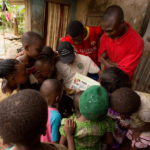On the Road to Malaria Elimination, Where Have We Been and How Can We Succeed?
Guest post by Rebecca Shore, VectorWorks*

Dr. Clive Shiff , Johns Hopkins Malaria Research Institute
I arrive to an office showing years of experience.
Journal articles strewn across the desk with wall hangings depicting various programs and projects Dr. Clive Shiff has impacted. When you first meet him his sweet demeanor, age and Zimbabwean accent, make you feel like you’ve known him for years. Shiff holds a faculty position in the Bloomberg School of Public Health Molecular Microbiology and Immunology Department. With over fifty years of experience working in the study of tropical parasitic disease, malaria epidemiology and control and medical entomology, he is well equipped to help us better understand what it takes to “End Malaria for Good,” this year’s World Malaria Day theme.
For thousands of years malaria has been affecting the human population. Before the introduction of insecticides like dichlorodiphenyltrichloroethane (DDT) and treatments such as chloroquine, malaria was rampant throughout the world. Eradication efforts didn’t began worldwide until 1955, after the introduction of DDT (1939) to reduce the mosquito population and chloroquine (1946) to treat the malaria infection. The combination of these two compounds for control and treatment, respectively, allowed for large-scale malaria control efforts to begin.
Multipronged Strategy
Effective malaria control requires a multipronged strategy that involves diagnosis, treatment, and prevention. Diagnosis to identify cases of malaria through a laboratory diagnosis or a rapid diagnosis test (RDT). Treatment to kill the active parasite forms in the blood including , atovaquone-proguanil, artemether-lumefantrine, and mefloquine. Prevention through vector control efforts such as insecticide-treated nets (ITNs), indoor residual spraying (IRS), and targeted larval control. This strategy can be straightforward, but many other factors can help or hinder that strategy. Dr. Shiff says that the crucial elements required to achieve elimination are health infrastructure, political will, and strong surveillance systems with scientists who understand them.
Health Infrastructure
Throughout our talk, Dr. Shiff emphasized the need for improved health infrastructure. He stated, “If you don’t have infrastructure, you don’t have [malaria] control.” In Shiff’s home country of Zimbabwe, the government began an IRS program in 1949 using the insecticides DDT and beta-Hexachlorocyclohexane (BHC), and were able to control malaria in four-fifths of the country from 1950 to 2000. In 1980 when President Robert Mugabe took power, Zimbabwe had one of Africa’s best health systems and one of the highest life expectancies of 61. However, corruption, mismanagement of the economy, and rampant violence led to a decline in many government programs and a full-blown humanitarian crisis. This included a collapsed health infrastructure which derailed malaria control efforts.
Having a strong health infrastructure includes effective stock management and resupply systems for artemisinin-based combination therapy (ACT), sulfadoxine-pyrimethamine, ITNs, RDTs, and other malaria commodities to meet demand, proper supervision to manage health workers and supplies, and proper diagnostics and surveillance systems to identify malaria cases.
Political Will
Political will plays an enormous role in improving health outcomes and reducing disease burden, especially in areas such as malaria. A government must decide it wants to move toward elimination, and through that, commit to funding and supporting those efforts. In the United States, changes in policies and farming practices changed where people lived and how they lived, which reduced transmission of malaria. Dr. Shiff explains;
The final crux in North America was political changes in the country that stopped share cropping, which tended to exacerbate malaria problems. [They] didn’t build their houses in the middle of the fields, they put their houses at the periphery where they were away from any arable land near rivers. When the government stopped share cropping and those people were reallocated, redistributed to cities and towns, the towns were laid out, the houses were built with rectangular windows with screens and the contact between people and mosquitoes disappeared. The parasite rate in the population dropped to an unsustainable level. There are still mosquitoes that [could] transmit malaria, but there is no parasite.
Strong Surveillance Systems
As an epidemiologist, Dr. Shiff believes that surveillance systems which gather accurate and complete data on malaria incidence and parasite population enable targeted prevention efforts. With this information you are able to choose the right intervention, for example deciding between IRS or ITNs. The battle for malaria elimination is two-pronged: “one is to reduce the longevity of the mosquitoes, so they don’t [live long enough to] transmit malaria; and the other is to reduce the parasite population,” adds Shiff. By using ITNs, IRS, and targeted larval control we are able to reduce the mosquito population. With decreased parasite transmission through the prevention of biting and proper treatment, we can reduce the overall parasite population.
Understanding transmission in a particular area can allow for a tailored approach to malaria prevention. If there is parasite resistance to a specific drug or mosquito resistance to a particular insecticide, other treatment options or insecticides can be used. However in Shiff’s mind, the data is not enough. Programs need qualified scientists to evaluate and draw conclusions from the data and understand the epidemiology of malaria as well as the entomology of mosquitoes. An outbreak of malaria can be due to insecticide resistance in an area with universal ITN coverage or IRS, a heavy rainy season, or insufficient diagnosis and treatment; very often, there are multiple contributing factors. Knowing exactly what happened and how to remedy it is something that takes a specific skillset in understanding disease and biology. Having more trained scientists in the fields of public health entomology and vector control is one key to sustaining successful malaria prevention. To achieve this, Shiff emphasized expanding university programs in endemic countries to provide training in entomology, biology, malariology, and epidemiology so that qualified staff are making informed decisions on how to proceed with malaria control in a given geography.
My conversation with Dr. Shiff helped me understand the magnitude and complexity of what is needed to achieve malaria elimination. Each recommendation is multifaceted and include funding and programmatic considerations and political backing. Looking toward the future, we need to try to achieve strong health infrastructure, encourage political will to support malaria elimination, and hopefully we can one day “end malaria for good.”
What is your country doing to “end malaria for good?” Does your organization have experience conducting SBCC for elimination? Join moderators Andrew Tompsett (PMI), Mike Toso (HC3), Rebecca Shore (VectorWorks) and Bill Brieger (Johns Hopkins University) for a conversation on April 25-26 – has social and behavior change communication been integrated as part of the solutions and strategies needed in the malaria fight to the final mile to elimination? If not, what needs to done?
[button link=”https://healthcomspringboard.org/discussions/topic/world-malaria-day-2016-3/” size=”medium” target=”new” color=”blue”]View the Discussion on Springboard here.[/button]
*Rebecca Shore is VectorWorks Knowledge Management Officer. The original post can be found here on the VectorWorks website.








Leave a Reply
Want to join the discussion?Feel free to contribute!